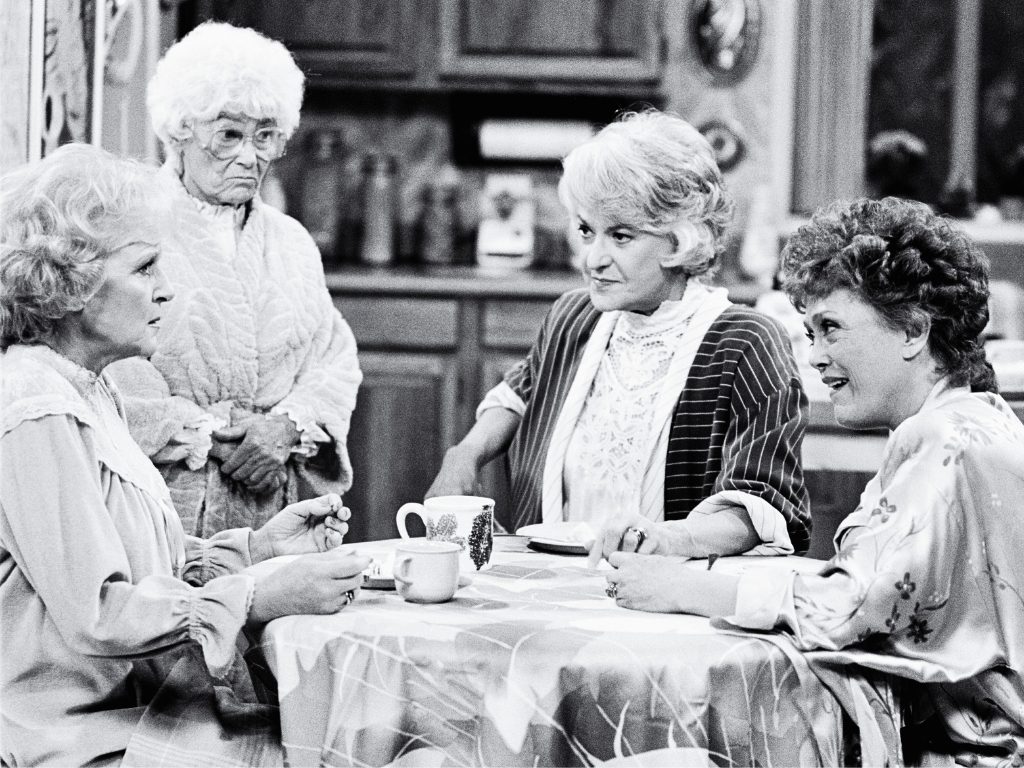
Image: ABC Photo Archives/Getty
Picture it: Prospect Heights, Brooklyn, 1985
I’m 12 years old, having a weeklong sleepover at my grandmother’s apartment. Outside wild dogs bark all night long and there’s a very active crack house around the corner. (This was way before the yuppies gentrified the neighborhood.) Every night at 7:00 p.m., my grandmother puts on her pink quilted housecoat, grabs her keys to double lock the door, and we visit all her neighbors on the third floor. First we go to Esther’s apartment across the hall where we find her working on the New York Times crossword puzzle. Then we head over to Sam’s place. He shows off his expensive tchotchkes, explaining their origin in excruciating detail. Finally we settle in at the apartment of the three sisters who’ve lived together all their lives.
The Golden Girls Lifestyle: The Growing Trend of Female Communal Living
Eva, one of the sisters, hands me a bowl of Breyers chocolate ice cream with rainbow sprinkles. We all gather in front of the television and wait for her to adjust the rabbit ear antennas so we can watch this new show called the The Golden Girls.
My Grandmother’s Own Golden Girls Experience
What I hadn’t realized until years later is that my grandmother had her very own Golden Girls experience right there in her apartment building. She and her friends shopped together, enjoyed meals, and accompanied one another to appointments, all while providing a deep sense of friendship and an unbreakable bond. Talk about giving new meaning to the words “til death do us part.”
Now, my bestie and I, both in our fifties, want what Grandma had. But rather than an apartment building in Brooklyn, we dream of sipping cocktails poolside on the lanai of a four-bedroom villa on the Mediterranean, talking smack, sharing cat memes, and reminiscing about our wildest travel adventures.
It turns out, we’re not the only ones. With a record 4.18 million people reaching retirement age in 2025, women 50 and up are redefining how they want to live. From financial stability to friendship, and everything in between, The Golden Girls trend is on the rise.
Why Women Over 50 are Choosing Communal Living
Communal living comes in many forms, from moving in with friends or family to living in your own house within a self-governing cooperative community. Samantha Rosen, editor of the forthcoming A Home for Tomorrow, an anthology about building community through shared space and values, said, “The systems in place to support our aging population aren’t great; it’s up to us to take care of each other. So if you’re 50 or 60 or 70 and are thinking about what the next decades of your life might look like, consider what kind of daily support, care, and company you want to give and get.”
This is exactly what Deborah Miranda began thinking about when she and her wife joined River Song Cohousing in Eugene, Oregon, in 2022. “We decided that what we wanted for our ‘third act’ was community,” said the 63-year old. River Song has 28 individual houses and includes common areas, gardens, and three potluck meals a week. Miranda said that the best part about living in such a tight-knit community is the sense of belonging. “Co-housing is very much about chosen family.”
The Benefits of Communal Living
Supporting one another is key at River Song. When Miranda’s sister passed away, her neighbors helped her honor her loss and checked in on her wife and dogs while she was out of town. The little day-to-day things are important, too. The community created Slack channels where members can ask for anything from a ride to the doctor to borrowing an onion.
Other communal living situations involve people pooling their resources to buy a home together because housing prices are out of control. Rising inflation, maintaining a house once your children fly the nest, divorce, health issues, and loneliness are all reasons women over 50 are opting to rent out rooms, invite family members, or move in with their kids.
According to the Pew Research Center, the number of Americans living in multigenerational households quadrupled between 1971 and 2021. Della Padnick, age 66, from Oregon City, Oregon, moved in with her daughter, son-in-law, and two young granddaughters to help with childcare and spare her daughter the enormous expense of daycare.
Done with living in a small studio apartment and making the long drive to see her family, Padnick now enjoys a big house with a yard to garden. Being closer to family also gives her piece of mind. She knows if something happens to her she’ll be well taken care of. And, as a bonus, with two active grandchildren, she never worries about being lonely. “My grandchildren wake up every morning with a joy to greet the world and learn about all the new things they haven’t yet experienced. It’s contagious.” she said.
Challenges of Living with Friends and Family
Communal living offers opportunities for connection on a deeper level, but it can get dicey. As The Golden Girls so perfectly illustrates, even the closest friends and family are going to have disagreements. For every easygoing Rose, there’s a Blanche that’s ready to shake things up and a mother/daughter duo like Sophia and Dorothy who are more than happy to say exactly what’s on their minds. Everyone needs to go into the arrangement with eyes wide open and expect a period of adjustment.
In co-housing communities like River Song, you’re often on the hook to attend meetings, your sense of privacy may not be what you’re used to, and there are a lot of personalities involved. Moving into a single household with friends or family can mean changing up your meal time, agreeing how loud is too loud to blast your music, and how many lights really need to be on in the house. For Padnick, it means not mentioning the dishes piling up in the sink. “After a lifetime as an adult and having my own home, you can get caught up in having things your way. You have to let the small things go,” she said.
Rosen agreed. While doing research for her book, she learned that communal living can be hard work. “There needs to be regular conversations and planning to make sure everyone involved is getting what they need out of the arrangement.” But that doesn’t mean it’s not worth it.
Planning for the Future: The Golden Girls Our Way
This is all great advice as my bestie and I continue to dream up the details for our villa. We constantly send one another links to Mediterranean homes because, as Rosen said, “Getting creative and expanding our thinking about the possibilities of housing and community can only help us as we get older.”
So far our Mediterranean villa rules include making sure there’s always an emergency cheesecake in the fridge, no bad-mouthing Dolly Parton—we love her—and binge-watching The Golden Girls reruns at least twice a week. Oh, and every day, I’ll thank her for being a friend.


Your article certainly points out the numerous advantages (not just lower bills, but shared land, time with family or friends, care and help) of multigenerational or communal living. We tend to think of “having” to live together instead of viewing it as an alternative, sometimes preferable choice.
Thank you for this article!
Hi Jennifer, Thank you for this thoughtful note! You’re so right—we often frame multigenerational living as a last resort rather than an intentional choice that can offer deep connection, support, and even joy.
I’m curious: what do you think it would take to shift the cultural narrative from “having to” live together to wanting to? Would love to hear your thoughts.
—Susan